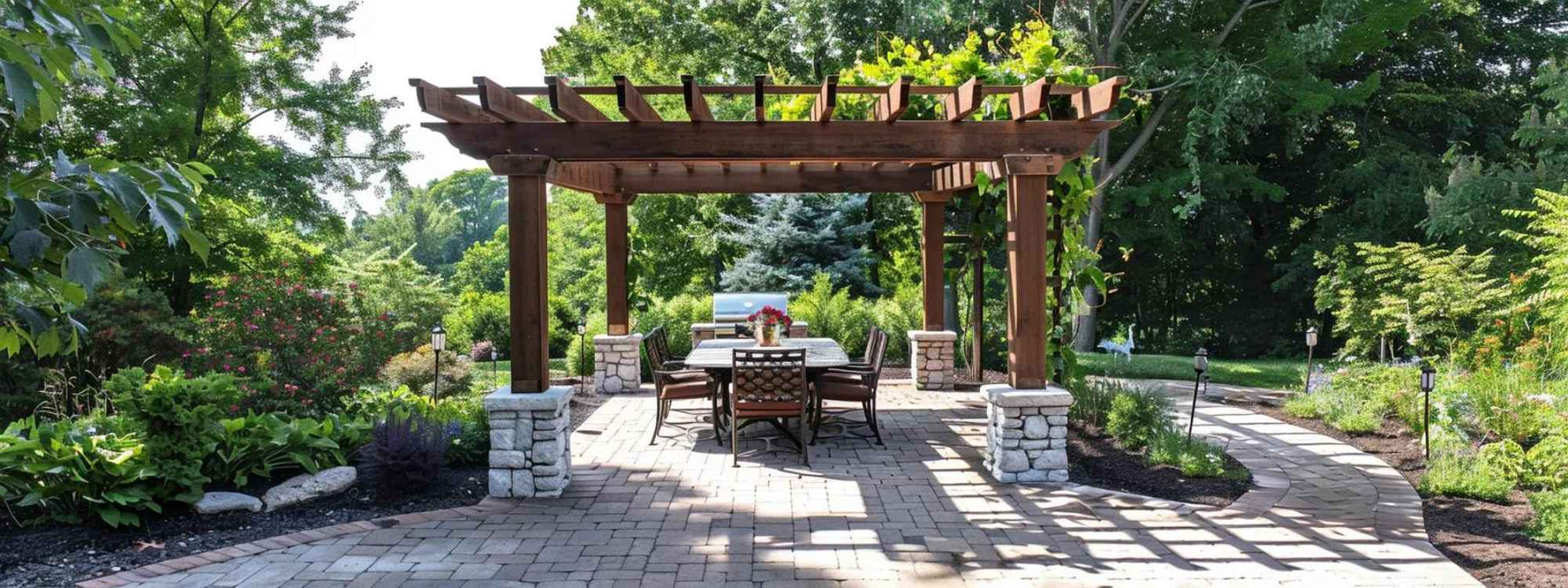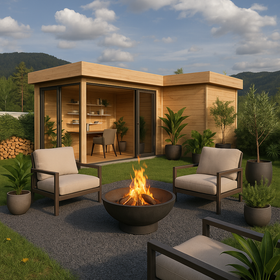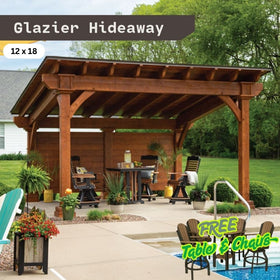512-777-0154

How Much Shade Does a Pergola Provide?
A sleek pergola stretching across your backyard patio, the perfect spot for weekend lounging or that casual dinner with family. It looks great, no doubt about that. But there's one lingering question: will it give you enough shade?
It depends.
Pergolas aren't like umbrellas. They don't offer complete coverage. Instead, they filter sunlight, creating partial shade that's more cozy than fully shaded. Think of it as comfortable relief rather than total sunblock.
But figuring out exactly how much shade you’ll get can feel tricky. The angle of your pergola slats, the spacing, and even the time of day affect how much sunlight sneaks through.
Do Pergolas Even Give Real Shade?
Yes, pergolas do provide shade, but probably not the type you're imagining.
Pergolas are designed to offer partial shade, not total darkness. Think of them as a stylish compromise between being fully exposed to the blazing sun and sitting under a solid roof.
When we talk about partial shade, we're referring to filtered sunlight. Instead of completely blocking rays, a Brookside Timber Frame Timber Resort Pergola breaks the sunlight into gentle patterns. You’ll still feel warmth, see patches of sun, and experience a relaxing dappled effect—light and shadow working together. It’s shade, but softer.
How much shade you'll get depends on a few key factors.
Things like how widely spaced the beams are, the angle of the slats, and even the materials you choose all impact shade levels. For instance, closely spaced wood slats can block more sunlight, whereas wide-spaced metal beams allow more rays to filter through.
So, if you're after full patio shade, a pergola might not cut it. But if you're okay with partial sun and you appreciate an airy, comfortable feel, it could be exactly what your backyard needs.
What Affects the Amount of Shade a Pergola Provides?
Not all pergolas deliver the same amount of shade. It would be nice if they did. But the reality is, a lot depends on design details. You might love the look of a pergola you saw online, but will it give you enough shade in your backyard?
To figure this out, you need to understand four main factors.
1. Slat Orientation: Why Angles Matter More Than You’d Think
Slat orientation sounds technical, but it’s pretty simple. Pergolas come with either adjustable or fixed slats. These slats aren't there just to look nice. How they're angled determines how much sunlight sneaks through.
If your slats run north to south, your pergola creates shifting patterns of light throughout the day. It's like having an ever-changing sundial above you. Sometimes shaded, sometimes sunny. But if the slats run east to west, you’ll get steadier shade during the midday sun.
Want more consistent shade when it counts? Go east-west. Prefer something visually appealing with changing shadows? North-south works well.
2. Spacing Between Slats: Bigger Gaps, Less Coverage
The wider the gaps between the beams, the less shade you get.
Brookside Timber Frame Highlan Oasis Pergola slats usually range between 1 and 3 inches apart. Closer spacing means less sunlight and more shade. Wider gaps might give your pergola a modern, airy look, but it lets in more sun.
If you’re someone who likes DIY projects, here’s a quick tip. Grab a flashlight and some paper strips. Lay the strips out on a table, leaving various gaps between them. Shine the flashlight down and see how much light passes through each gap.
It's a simple test that can help you visualize how spacing affects the shade.
3. Roof Style: Open, Louvered, or Solid?
Roof style changes everything.
Most classic pergolas have an open-top design. They look great, offering that iconic, dappled shade you probably imagine when thinking about pergolas. Sunlight filters through softly—nice, but not fully protective.
On the other hand, you’ve got louvered pergolas. The louvers or adjustable slats let you control how much sun comes through. Want more shade around noon but more sun in the late afternoon? Just adjust the angle. It’s shade that fits your mood.
Solid-roof pergolas provide the ultimate shade—no beams, no gaps, just full coverage. But they’re more like gazebos, offering less of the open-air experience pergolas are known for. The good news is that with smart materials and thoughtful designs, you don't have to sacrifice looks for functionality. You can find a style that strikes a good balance between shade and aesthetics.
4. Time of Day and Sun Angle: The Shade is Always Moving
Here’s something many pergola buyers overlook: shade moves. A Brookside Timber Frame Shadelan Retreat Pergola that gives great coverage at noon might leave you roasting at 5 p.m. Why? Because the sun shifts, and the angle changes dramatically throughout the day.
If you’re serious about planning the perfect pergola setup, consider using apps or online tools that track sun paths across your yard. These tools can show exactly where shade will fall at different times.
Pergolas don't guarantee constant shade. Instead, they give you flexible, shifting coverage. The key is to align the design with when you use your outdoor space the most.
Material Matters: Which Pergola Materials Offer the Best Shade?
Shade isn’t just about structure, it’s also about what your pergola is made of. Some materials give you dappled light. Others block most of the sun. And a few sit somewhere in between.
The material you choose affects everything: the amount of shade, how hot it gets underneath, how it holds up over time, and how much control you have when the sun shifts.
1. Wood: Natural Beauty, Medium Shade
Wood is the classic choice.
It looks warm and solid. But when it comes to shade, it depends on how it’s built. Most wood pergolas, like Outdoor Living Today Western Red Cedar Pergola & Canopy, have gaps between the slats, which means the shade isn’t total. You’ll get a nice, scattered light pattern enough to cool things down, but not fully block the sun.
Want more shade? Add a canopy or train some climbing vines over the top. Wisteria, ivy, or grapevines work well and add more coverage without changing the structure.
2. Metal: Modern Looks, Adjustable Options
Aluminum and steel pergolas often come with louvers that can tilt. That’s a game changer. You get to decide how much light or shade you want, depending on the time of day.
Metal pergolas usually feel cooler underneath, especially if you go for powder-coated finishes. That coating isn’t just for style; it also reduces glare and reflection, which helps make the space more comfortable.
3. Fabric Canopies: Full Control of Sun and Shade
If you want total flexibility, fabric’s hard to beat. Retractable canopies let you slide the shade open or closed depending on the sun.

You can block nearly all sunlight when needed or roll it back to enjoy a bit of warmth. It’s a simple solution with maximum control, especially if you’re not into complicated installations.
4. Polycarbonate Panels: Shade Plus UV Protection
Polycarbonate gives you the best of both worlds: light comes through, but UV rays don’t. These clear (or tinted) panels act like a filter, letting in brightness without the burn.
They also protect against rain, which is a nice bonus if you use your space year-round. The feel stays open and airy, but you’re more shielded than with slats alone.
Can You Boost a Pergola’s Shade Without Rebuilding It?
You might have your Brookside Timber Frame Zion Resort Pergola set up already and realize later the sun’s still winning. It happens more often than you’d think.
You don’t need to tear it all down and start again. Instead, consider a few smart add-ons that bump up the shade factor without major renovations.
Retractable shades or sun sails are probably the easiest fix. They slide open or closed as needed. Sun sails can even give your outdoor area a modern look, providing targeted shade exactly where you want it.
Want something more natural? Climbing plants like grapevine or wisteria create leafy canopies. They look beautiful, and once mature, their leaves filter sunlight effectively. Just remember—plants take time. You won’t get instant results, but patience pays off.
Outdoor curtains are another quick solution. They provide flexible coverage from the side and can be pulled shut when the sun angles low in the afternoon. Plus, they add a touch of privacy.
And if you’re clever, layering some of these methods, like vines plus a retractable shade, can deliver close-to-complete coverage at peak sun hours without needing a solid roof.
Simple tweaks. Smart coverage. No rebuild necessary.
Shade Isn’t One-Size-Fits-All, So What’s Right for You?
It’s easy to get caught up in the perfect pergola photos online. But real life isn’t always filtered through a lens.
The right amount of shade depends on how you use your space. Do you spend afternoons out there reading? Or is it just for evening dinners? Your habits matter more than the design trends.
Pergolas can be flexible. You can go open and airy, or build in extra coverage with fabric panels, curtains, or climbing vines. There’s no single right way, just the version that fits your lifestyle.
And if you’re realizing that slats alone might not cut it, that’s fine. There are easy ways to add shade without starting from scratch.
Want more tips on creating a better outdoor setup? We cover that too. Check out our blogs.
You’ve got options. Take your time, choose what works, and build something that feels like yours.








